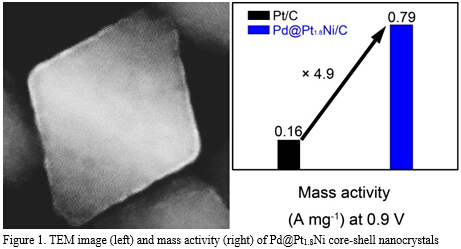Breakthrough in the Fabrication of Efficient Electrocatalysts for Oxygen Reduction Reaction

Recent years have witnessed mass consumption of fossil fuels and deteriorating trend of environmental pollution. Investigation and application of new clean energy, represented by proton exchange membrane fuel cells (PEMFCs), has consequently received extensive attention around the world. However, low activity and stability of catalysts in ORR at the cathode have been existing as the main technical bottlenecks, rendering commercialization of PEMFCs relatively difficult. Therefore, it is of significant importance to design and fabricate both active and stable catalysts for ORR.
Based upon theoretical studies of crystal growth, researchers in Zeng Group successfully designed and prepared core-shell Pd@PtNi nanocrystals with ultrathin shells composed of Pt/Ni alloy. The atomic ratio of Pt to Ni could be precisely tuned from 0.6 to 1.8. The as-prepared nanocrystals, with extremely high utilization of Pt atoms, are able to provide active crystal facets for catalysis in ORR. Especially, the mass activity of Pd@PtNi was 0.79 A/mg, which was approximately 5 times as that of the commercial Pt/C (0.16 A/mg). The nanocrystals also exhibited noticeable stability, almost remaining unchanged in activity after 6000 cycles of use. This work provides an important instruction to the development of efficient Pt-based nanocatalysts.
This work was supported by MOST of China and the National Natural Science Foundation of China.
Source: http://pubs.acs.org/doi/abs/10.1021/ja511596c
Back
